AMD Announces New, Higher Clocked Radeon HD 7950 with Boost
by Ryan Smith on August 14, 2012 11:00 AM ESTPerformance, Power, Temperature, & Noise
Because the 7950B is not strictly a new SKU, and because the performance of the 7950B isn’t very far ahead of the 7950, we’re going to keep our look at the 7950B’s performance relatively short. As always, if you want a complete breakdown of performance please see Bench, which has our complete results for the 7950B and over two dozen other cards.
Kicking things off, we wanted to start with a quick look at clockspeeds. Unfortunately AMD still hasn’t come through on their promise to expose the precise clockspeeds of their Southern Islands cards, which means we’re stuck looking at clockspeeds in a halfway blind manner. We cannot tell when PowerTune throttling has kicked in to push clockspeeds below 850MHz, and at the other end of the spectrum we cannot tell what PT Boost is doing when it’s boosting. As a result we can only see two card states, the base state of 850MHz when the 7950B is operating at or below 850MHz, and the PT Boost state of 925MHz when the 7950B is operating at between 851MHz and 925MHz. Still, this is just enough information to piece something together.
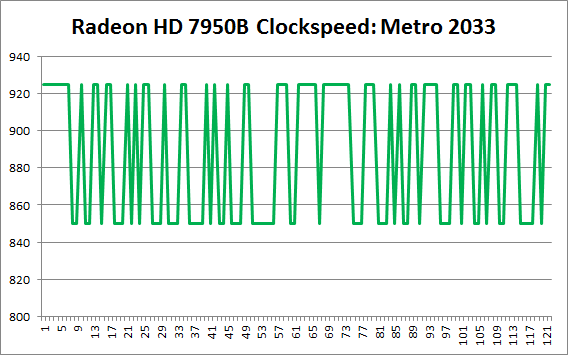
The above is a graph of clockspeeds when running Metro 2033 at 1920x1200, and it’s virtually identical to what we see with other games. The 7950B fluctuates wildly between its base state and its boost state. This is not the kind of behavior we see from the 7970GE or for that matter NVIDIA’s GTX 600 cards. This fluctuating behavior is unique to the 7950B.
So what’s going on? As near as we can tell, the power requirements for boosting are so high that the 7950B simply cannot maintain that boost for any significant period of time. Almost as soon as the 7950B boosts needs to go back to its base state in order to keep power consumption in check. The culprit here appears to be the 7950B’s very high boost voltage of 1.25v, which at 0.125v over the card’s base voltage makes the boost state very expensive from a power standpoint. If our theory is correct then this means that the 7950B never gets very far past its base clockspeed, and compared to the 7970GE, PT Boost is almost entirely wasted here.
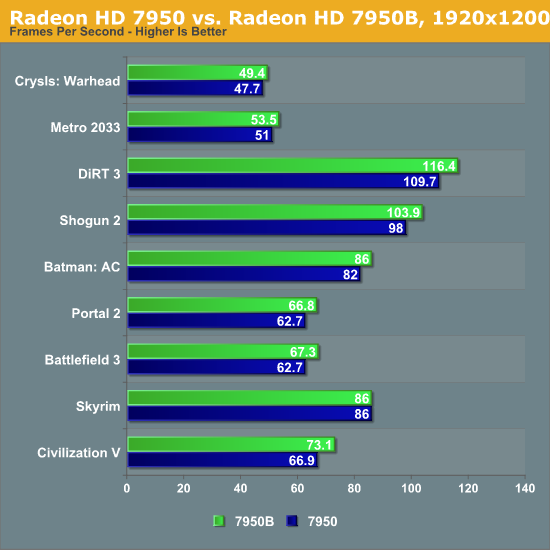
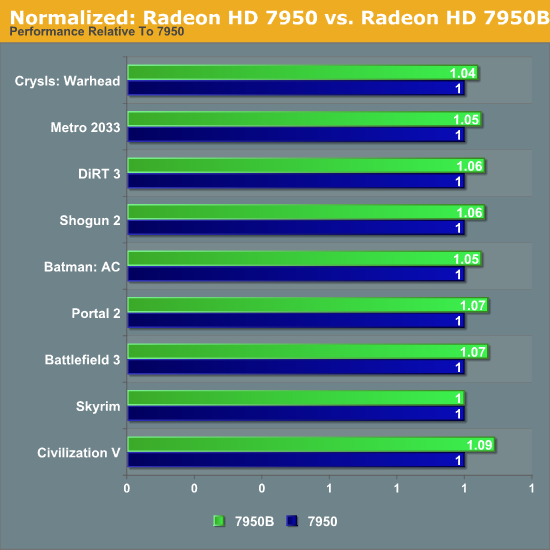
Looking at our performance charts, what we’re seeing would seem to confirm our theory. Keeping in mind that the base clockspeed of the 7950B is 6.25% higher than the 7950, the only time we see a significant jump in performance beyond that is with Civilization 5, where performance increases by 9%. Otherwise performance increases by merely 4% in Crysis, up to 7% in Battlefield 3. Not counting Skyrim (which is CPU limited), we’re looking at an average performance gain of just over 6%, which is very close to the increase in the base clockspeed relative to the 7950.
As we’ve stated before this is free performance and we’re happy to take it, but at the end of the day 6% is not nearly enough to matter with the current competition. Until such a time where the competitive landscape changes, the 7950 will continue to be well behind its next-closest competitor, GTX 670.
Power, Temperature, & Noise
Bringing things to a close, we quickly wanted to break out power, temperature, and noise. As we’ve stated earlier, AMD is making a clear set of tradeoffs with the 7970GE and 7950B, forgoing power efficiency in the name of performance. We’ve seen the 6% performance boost the 7950B offers, but what exactly has the cost been?
| Radeon HD 7950 Series Voltages | ||||
| Ref 7970B Base Voltage | Ref 7950B Boost Voltage | Ref 7950 Base Voltage | ||
| 1.125v | 1.25v | 1.093v | ||

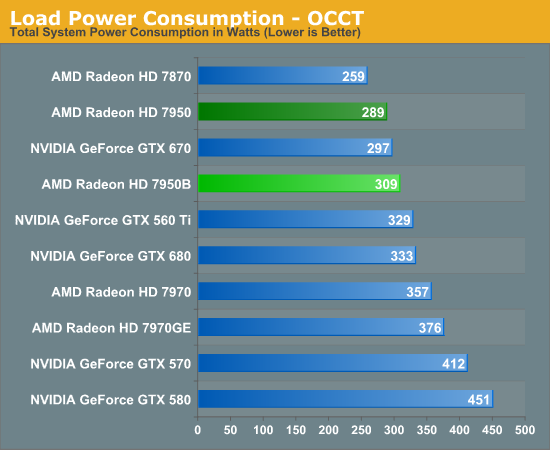
Starting as always with load power, we see that relative to the 7950, the 7950B’s power consumption at the wall is 20W higher in both tests. This fits well with AMD’s official specs, which have the TDP of the 7950B at 225W, versus 200W for the 7950. As a result of this power increase the 7950B draws more power than even the GTX 680 when it comes to Metro, though thanks to AMD’s more rigorous throttling their power consumption still comes in below the GTX 680 under OCCT.
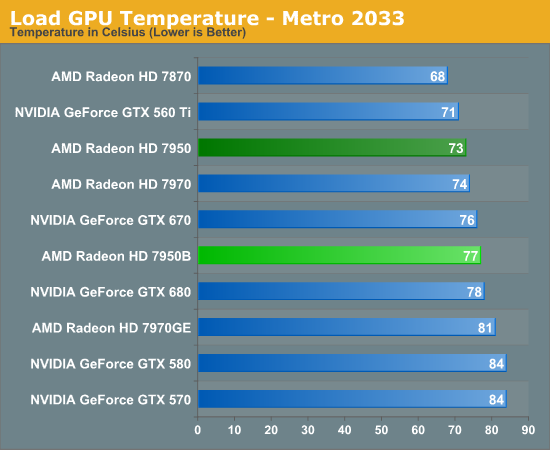
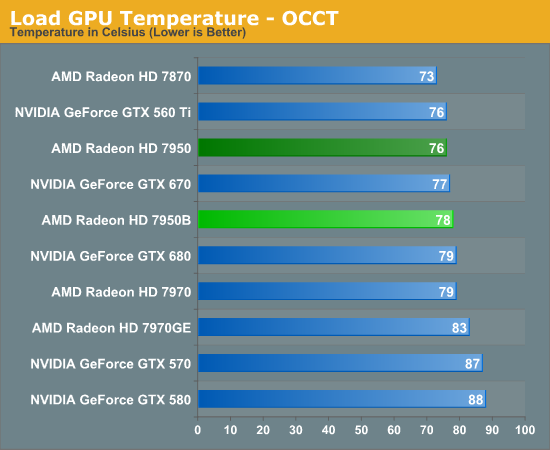
Moving on to load temperatures, it comes as no great surprise that with an increase in power consumption comes an increase in load temperatures. The 7950B still fares well here, staying below 80C in both tests, but the 4C jump in Metro is a bit more than we would have expected for only a 20W increase in power consumption.
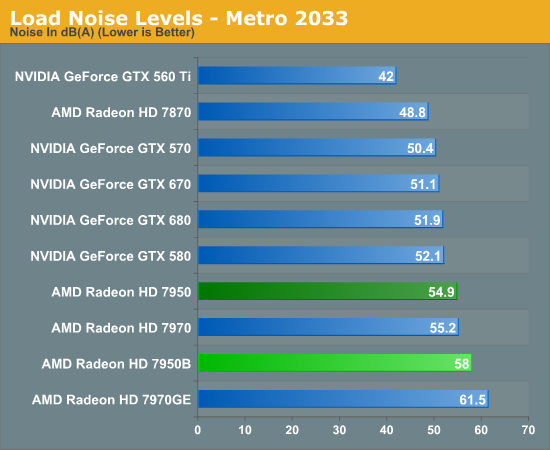

Last but not least we have our look at noise under load. Unfortunately the 7950B looks especially bad here, thanks to the more aggressive fan curve we typically see on 7950 cards. With both Metro and OCCT the 7950B is pushing 58dbA+, which is louder than even the better performing 7970. In fact all things considered this is quite a ridiculous amount of noise, the same problem the 7970GE had.
The good news is that the reference 7950 is rarely sold these days, but we have every reason to believe that aftermarket cards will see a similar jump in noise. There’s no getting around the fact that 225W is a lot of heat to dissipate, especially for designs that weren’t necessarily optimized around that level.
Wrapping things up, it’s difficult to hold a favorable opinion of the 7950B given what we’ve seen so far. AMD may be putting all of their focus into performance-per-dollar, but that doesn’t mean that performance-per-watt has suddenly stopped mattering. The 7950B’s performance boost is free from a price perspective, but the tradeoff that comes with it is anything but. A 6% jump performance for a 10% increase in power consumption and notable rise in load noise will certainly be acceptable to some users, but it’s difficult to argue that this is a good tradeoff overall.










58 Comments
View All Comments
Rick83 - Tuesday, August 14, 2012 - link
And I thought that we were over that chapter with the last generation of cards.Oh well, let;s turn up that voltage and crank up those clocks, we can always get triple 8-pin pcie power!
225 Watts in an upper mid range card is just a bit too much.
bennyg - Wednesday, August 15, 2012 - link
</IMO>If the card can do it, why not improve the primary functionality of this class of GPU, crunching graphics. If for some reason 200W is OK for you and 225W isn't... cue tada.wav now - don't upgrade it's BIOS.
I've heard too the new model Viper gets no more MPG than the Gen 4.
JPForums - Wednesday, August 15, 2012 - link
The 7950 isn't upper mid range. (At least in AMD's eyes.)
High end - 79xx
Upper Mid range - 78xx
Lower Mid range - 77xx
Low End - Higher end A-Series processors (76xx/75xx)
Entry Level - Lower end A-Series/E series Processors
I understand the confusion given the low end discrete market has been largely displaced by Integrated GPU's. I also have a hard time deciding whether the 7870 performs like a high end card, or the 7950 performs like an upper mid range card. I like to draw the line at the up coming GTX660(Ti). I wouldn't call my GTX670 mid range, but I wouldn't call any form of GTX660 high end. My guess is that the 7950B will slot in between the two in performance. If it doesn't then it will go down as a high end card that performs like an upper mid range card.
I'm glad they revamped the 7950 as it had plenty of power headroom for a high end card and its performance was too close to the 7870. I just wish they would have named the new 7950/7970 - 7955/7975 (or if you prefer 7960/7980). They could still let the 7950 fade out. There is still no need for a new reference design. There would be no confusion when buying in the interim. It would accurately reflect the marginal upgrade in performance. Honestly with all the new model numbers assigned to old parts that both nVidia and AMD use to make products appear new and better, I can't imagine why either of them would choose not to rename a legitimately different part.
JPForums - Saturday, August 18, 2012 - link
It seems the 7950 trades blows with the reference GTX660Ti. It wins some and looses some. However, it suffers some pretty massive loses in games like Battlefield 3 and Shogun 2. However, it seems the 7950 has better resilience at higher resolution. Overall, it comes up short though, so it is a good thing AMD released the update. The 7950B, overall, seems to maintain a small margin of victory over the overclocked variants of the GTX660Ti, thus saving face as a high end card (even if barely). It will be interesting to see how well the 3GB GTX660Ti does. It doesn't have the asymmetric memory penalty that the 2GB variants have.n0x1ous - Tuesday, August 14, 2012 - link
u mad bro?hechacker1 - Tuesday, August 14, 2012 - link
With the voltage already set higher in the bios, I wonder how these cards overclock?I know they are low quality parts, but considering not every single one of these requires 1.25V, I bet some of them overclock really well. Plus you wouldn't have to resort to driver/bios hacks to get it running at a higher voltage.
But I guess then you might run into the PSU limit of trying to power it.
CeriseCogburn - Wednesday, August 29, 2012 - link
Where's the big rant about amd's failing gpu production where their cores need extra voltage for a tiny OC ?LOL
I thought we'd get ten pages of the "astute" amd fans who spent three years+ bashing nVidia's "process" since the - heck 4-5 years since the 200 series.
Where did they all go when the amd crapship needs a giant voltage bump to come out barely above where it wsa before and WAY BELOW WHERE ALL THE AMD FANBOYS HAVE BEEN CLAIMING FOR ALMOST A YEAR IT PASSES ON OLDER LOWER STOCK VOLTAGE...
Where's all the whining and moaners and laughing fools screaming housefire on amd's failing fire hot core production ?
I guess they... I was going to say finally went looking for a job so they wouldn't have to whine about price all the time but the economy clearly nixes that...
I guess I'll have to fill in for them...
amd = 1.7% good cores
amd= CEO's fled the housefires
amd= another stupid move
amd= no problem our fanboys will suck down and swallow the koolaid
martyrant - Tuesday, August 14, 2012 - link
It's pretty obvious why this is happening the way it is (and when), and why there is no name change. They're getting ready to compete with the gtx 660 that releases this month (supposedly) and instead of the time and money it would take to create a new card, they devised this BIOS "hack"/"update" as a response.Would like to see a GTX 660 review from here, as I think they're starting to pop up around the web (saw at least one already). While typically an ATi fanboy since the 9700 series (my first was a 7500, which predates that a bit) I've noticed that this round in the ring it seems to be in favor of nVIDIA (and while I've had a few great nvidia cards, I've most lately become accustomed to being able to use eyefinity).
Seeing as nVIDIA now has 3+1 displays, I might give it a shot this time around--still waiting to decide on what to upgrade to--but being able to use up to 6 is quite nice in my opinion. With the price drop of the 7970 now it makes a lot of sense compared to the 670/680, but with the 660 coming into play soon we may see a new price/performance king. I just read a ton of horror stories on AMD's driver support for their top tier cards these days...
Anyway, 660 review please!
RussianSensation - Wednesday, August 15, 2012 - link
HD7970 is now faster than 670 and 7970 GE is faster than the 680 overall:http://www.computerbase.de/artikel/grafikkarten/20...
Take a 7950 and overclock it to 1.1ghz and see what happens to an overclocked 660Ti with MSAA enabled.
CeriseCogburn - Wednesday, August 29, 2012 - link
" I just read a ton of horror stories on AMD's driver support for their top tier cards these days..."LOL - reality bites